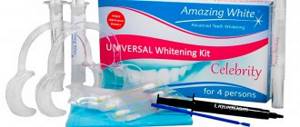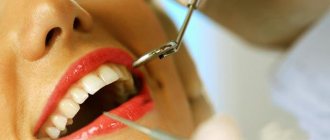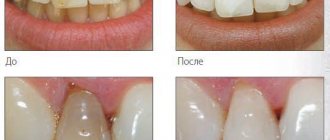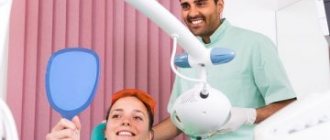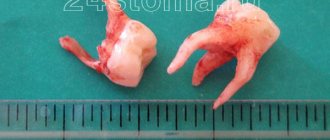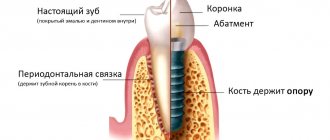Dentistry not only helps in restoring teeth, but also solves problems associated with soft tissues in the mouth. For example, when the space between the lips, teeth and gums is small. In this case, any movement of the mouth, smile, chewing process, speech, causes severe tension in the muscles and ligaments. Which leads to micro-tears and injury to the gums. And, as a result, to the appearance of problems with teeth and periodontal disease.
Vestibuloplasty in dentistry is a simple procedure for moving muscle tissue and ligaments in the oral cavity to reduce gum tension. Translated from Latin, “vestibulum” means “vestibule” - that very space between the gums and lips. The operation helps prevent such a dangerous disease as gum recession. And returns the smile to an aesthetic appearance.
It is quite difficult to independently diagnose a shallow vestibule of the mouth: discomfort in the oral cavity appears after the gums have receded. When the roots of the teeth are exposed, sensitivity to temperature changes increases. The reason for the reduction of space in front of the teeth, and the indication for the vestibuloplasty procedure, can be trauma. For example, a burn or permanent mechanical damage due to improper brushing of teeth. There are also congenital pathologies that require surgical correction.
When should you consider vestibuloplasty?
Vestibuloplasty effectively alleviates the patient’s condition; you can resort to it by:
- cosmetic indications: pronounced aesthetic disturbances and cosmetic defects of the face caused by the small vestibule of the oral cavity;
- bite correction;
- increased tone of the mental muscles;
- correction and preparation of orthodontic mucous tissues before extensive treatment, prosthetics, implantation;
- disturbance of sound production and complicated phonation of some sounds due to the small oral vestibule;
Indications
As a rule, vestibuloplasty is prescribed before implantation, prosthetics and orthodontic treatment.
Installation of a removable denture, especially with complete edentia, is carried out only on healthy gums. Displacement or deficiency of the periodontium leads to premature wear of the orthopedic structure and injury to the mucous membrane. The vestibuloplasty procedure helps solve this problem.
Similar logic applies to the implantation process. It makes sense to implant a titanium rod only into healthy oral tissues with good blood circulation. Then the expensive structure will last a very long time. And it will become a complete replacement for a natural tooth. Both functionally and aesthetically. In this case, vestibuloplasty is indicated for successful fusion of the implant with the jawbone.
Malocclusion and problems with diction can also be associated with a small vestibule. Timely adjustment of the intraoral muscles will relieve discomfort and help achieve good results during orthodontic treatment.
Vestibuloplasty also helps eliminate external defects (unaesthetic smile, inverted lip, etc.). The sooner the patient contacts the dentist, the easier and faster the defect can be corrected. With age, the defect intensifies and becomes the cause of pathological diseases (periodontitis, periodontal disease, gum recession).
When is vestibuloplasty contraindicated?
In some clinical conditions there are a number of contraindications for this surgical intervention:
- complicated, multiple dental caries;
- pathologies of blood and hematopoiesis (leukemia, hemophilia), blood cancer;
- tendency to form keloid scars, collagenosis;
- maxillofacial osteomyelitis with destructive changes in bone tissue;
- recent radiation exposure to the cervical region and head;
- often recurrent chronic inflammation of the oral mucosa;
- the presence of malignant neoplasms;
- severe cases of diabetes;
- dysmorphophobia;
- cerebral vascular lesions;
- the patient has mental disorders, alcohol and drug addiction.
Contraindications
Vestibuloplasty in dentistry refers to a full-fledged surgical operation, which has its own contraindications and side effects. The procedure is contraindicated for the following diseases and conditions:
- acute inflammatory processes in the oral cavity;
- colds, ARVI;
- sinusitis;
- pregnancy and lactation;
- intolerance to anesthesia,
- malignant tumors;
- cerebral paralysis;
- serious mental disorders;
- alcoholism and drug addiction;
- osteomyelitis of the jaw.
Complications after the procedure are extremely rare, but in order to minimize them, vestibuloplasty should be performed in clinics with a good reputation, where there is modern, high-quality equipment and a certified surgeon.
Preparing for surgery
To successfully undergo direct surgical intervention, dentists recommend following the following rules:
- undergo preliminary x-ray diagnostics of the operated cavity;
- Do not use any medications, especially painkillers. If you need to constantly take any medications, indicate this to the doctor performing the operation;
- solid food is excluded 8-10 hours before surgery;
- it is necessary to perform proper hygiene procedures to remove accumulated plaque;
- Before surgery, check with your doctor about any concerns you may have. This will help get rid of excessive anxiety and fear, and will allow you to have a positive psychological attitude towards the operation. In this case, the period of rehabilitation and recovery will take place in the shortest possible time, with minimal discomfort.
Operation procedure
The vestibuloplasty procedure consists of three stages:
- Use of anesthetic. As a rule, local anesthesia (freezing effect) is used. In some cases, sedation is possible - inhaling a mixture of nitrogen and oxygen through a mask. This type of pain reliever calms, relaxes and lowers the pain threshold. It has no side effects, so it is often used in children's treatment.
- The surface of the gums is treated with a disinfectant. Then the doctor makes incisions and adjusts the position of the oral muscles and ligaments.
- The vestibuloplasty procedure ends with suturing.
Additionally, the dentist fixes a bandage with antiseptics and medications on the seams. After the operation, the patient is given recommendations for oral care.
Main stages of vestibuloplasty surgery
Vestibuloplasty is usually performed under local infiltration anesthesia. In children and in severe cases, inhalation or intravenous general anesthesia may be used.
Stage 1. Aseptic treatment of the operated cavity.
Stage 2. Dissection, cutting the space into the depth of the mucous membrane, between the movable part of the jaw and the gums. Depending on the required results, it can be produced using various methods, which will be discussed below.
Stage 3. Peel off the inner surface of the lip using special scissors. At the same time, along the periosteum, submucosal tissues (muscle, fat, tendons) are carefully moved deeper into the frontal and lateral sections. If necessary, dental papillae (cords) are excised with a scalpel.
Stage 4. The necessary positioning of the detached flap is performed. In this case, the exfoliated tissue is moved to the desired location and evenly distributed throughout the entire depth of the newly formed vestibule. An important point is that it is necessary to completely remove fibrous and muscle fibers from both the periosteum and the detached flap.
Stage 5. Fixation of the mucosal flap with ligature threads to the periosteum.
Stage 6. Applying a special aseptic, dental, forming dressing to the wound surface to form a protective fibrin film that will protect it until complete healing. A pressure bandage is applied to the lip and chin area.
Vestibuloplasty in Moscow: price
| — Vestibuloplasty | 6500 rub. |
| — Primary surgical treatment with suturing | 1000 rub. |
| — Manufacturing of a protective plate | 8000 rub. |
| — Collection of connective tissue graft | 4000 rub. |
| — Infiltration and intraligamentary anesthesia | 350 rub. |
| — Conduction anesthesia | 400 rub. |
View price list
Methods of mucosal dissection during vestibuloplasty
Clark's method
Vestibuloplasty according to Clark is an open method of vestibuloplasty and is the optimal solution for correcting the upper jaw. Its exceptional feature is that dissection can be performed over large areas of the oral vestibule without affecting the periosteal tissue. The incision is made to the depth of the oral mucosa along the transitional fold between the mucosa and the gums. The complex of submucosal tissues is moved along the periosteum line to a new depth, in the lateral section - 6-7 mm, in the frontal section - 10 mm. After the operation, a dental forming plate is applied, special attention is paid to the alveolar process, and it is covered with a special film. The period for complete healing is 15-20 days after surgery.
Tunnel vestibuloplasty
This method belongs to the closed methods of vestibuloplasty, is minimally traumatic (often used to eliminate dental problems in children) and can be used to correct both jaws. After infiltration anesthesia, dissection of the mucous membrane is performed, with 3 limited, small incisions made - in a vertical plane 20-25 mm long along the frenulum, along its entire length (from the place of attachment to the lip to the place of attachment to the gum) and two incisions in horizontal plane, along the connecting fold, towards the premolars with a length of about 20 mm. Through these incisions the mucous membranes are manipulated. Healing of the postoperative defect occurs quite quickly - 9-12 days from the date of surgery.
Edlan Meicher method
Most often used for correction of the lower jaw over the entire mucosal area. Local infiltration anesthesia is carried out using the hydropreparation method for better detachment of the mucosal flap. The mucosal surface is dissected along an arc parallel to the jaw line. At the same time, 10-12 mm recede from the gingival border of both canines; in the area of premolars and molars, 7-10 mm recede. Due to the positive dynamics and sustainable results, this method is widely practiced for vestibuloplasty and has a healing period of up to 2 weeks.
Glickman method
This vestibuloplasty is suitable for both local, small areas and relatively large areas. The dissection is made at the site of attachment of the lip, followed by detachment of soft tissue to a depth of 15 mm. The free edge of the resulting mucosal flap is sutured, offset, to the formed depression.
Schmidt technique
This technique involves, after an incision, detaching only the mucosal surface, while the periosteal tissue is not separated. The edge of the mucosal flap is immersed to the required depth of the cavity of the oral vestibule, and then sutured. A dental shaping bandage is applied to the operated areas, and a special pressure bandage is placed on the chin.
Limberg method
With this technique, 2 triangular opposing flaps of the lower lip are formed. The main dissection is along the crest of the frenulum, at the point of its attachment to the alveolar process. Next, two additional incisions are made: one at an angle of 70° from the main incision along the alveolar process, the other at an angle of 80° from the main incision along the mucous membrane of the lip. The length of the incisions in children is 0.5-2 cm, in adults - 2.5-3 cm. After gentle separation of tissue, the mucosal flaps are mutually moved and stitched with catgut.
Using a laser for vestibuloplasty
Vestibuloplasty using laser technologies is the most promising, innovative, minimally invasive surgical intervention. Using a laser, you can clearly predict the timing and results of plastic surgery, and clearly organize the entire treatment process.
Advantages of using laser in surgery:
- minimal impact on the nerve endings of the cut tissues, little pain;
- rapid postoperative tissue regeneration;
- precise and non-bleeding incision;
- burns of surrounding tissues are excluded, hypersensitivity of tooth enamel is not caused;
- prevention of disturbances in microcirculation processes;
- improved marginal fit of contacting surfaces;
- the possibility of infection of the operated tissues is excluded;
- destruction of pathological microflora, exclusion of purulent-destructive inflammatory processes;
- stimulation of tissue regeneration, absence of scar growths.
For vestibuloplasty, the following types of lasers are used:
- neodymium Nd:YAG laser - with good absorption in pigmented tissues (hemoglabin, melanin). Capable of cutting surfaces in continuous and pulse modes. The radiation is supplied via a flexible light guide;
- argon - with high speed and degree of polymerization of light-curing materials. When used, bleeding is effectively prevented and almost completely stopped;
- diode semiconductor laser - with good hemostatic effect and absorption by pigmented tissues. It has compact overall dimensions, is easily applicable in clinical settings, and has an effect that stimulates tissue regeneration.
Laser Application
In the traditional procedure, all surgical incisions are made using a scalpel. This is a classic, proven technique that has been around for many years. However, the trauma rate due to mechanical impact is much higher than when using hardware technologies.
Laser vestibuloplasty significantly reduces the recovery period. During the incision, the laser instantly cauterizes the tissue, preventing bleeding and swelling. The device allows you to make more precise and accurate cuts. Which promotes rapid healing of wounds and a more aesthetic appearance.
Rehabilitation activities
Depending on individual characteristics, patients after vestibuloplasty may experience numbness and loss of sensitivity of the oral mucosa, swelling, and discomfort when speaking. During the rehabilitation period, you can get rid of these manifestations by doing the following:
- rinse your mouth with a doctor-recommended mouthwash after each meal. Light brushing of teeth with a soft brush on the 4-5th day after surgery;
- following special dietary recommendations. The main diet should consist of pureed, soft dishes, purees. Alcohol, spicy, sour, hot and solid foods, dairy products are prohibited (they can provoke the formation of unnecessary bacteria)
- simple, regular, restorative exercises: external, light massage of the skin covering the operated area, touching the area of the vestibule of the mouth with the tip of the tongue, periodically pouting the lips for at least 2 minutes/up to 5 times a day;
- Regular visits to the doctor to monitor recovery and regenerative processes. Clinical control 3.6 months after the intervention.
Possible complications after vestibuloplasty of the lower jaw and the cost of the procedure
The main causes of complications after mandibular vestibuloplasty are non-compliance with doctor’s recommendations and poor oral hygiene. The main possible complications after vestibuloplasty include bleeding, low sensitivity, scar formation, and severe swelling of the gums. If the listed phenomena do not go away after vestibuloplasty for several days, seek the advice of a specialist to eliminate the risk of developing inflammatory processes.
You can find out the exact cost of lower jaw vestibuloplasty only after a consultation and examination with a dentist in Moscow - Vanstom. The price of the procedure is influenced by a variety of factors, which will be studied by a specialist from our dental clinic, after which he will be able to tell you the cost of the service. Vestibuloplasty of the lower jaw at Vanstom dentistry is quality, efficiency and a guarantee of 100% positive results!
How to treat emerging complications
Ignoring rehabilitation recommendations can lead to the occurrence of certain pathologies, namely:
- severe bleeding. To eliminate it, you should use hemostatic tablets, make cold applications with liquids for better blood clotting;
- the appearance of ligature fistulas. May be caused by individual intolerance to suture material. In this case, you should consult a doctor to prescribe healing medications;
- excessive swelling. It may be an individual feature; as a rule, it completely disappears within 3-5 days from the date of surgery;
- loss of sensation in the operated area. The norm is that the period of complete restoration of sensitivity can range from six months to 9 months. Physiotherapy (hydromassage, paraffin baths) and rehabilitation exercises help speed up the process.
Sources used:
- Surgical dentistry: Textbook for medical dental institutes / A. I. Evdokimov, I. G. Lukomsky, I. M. Starobinsky; With the participation of Associate Professor G. A. Vasiliev and Professor M. B. Fabrikant. - M.: Medgiz, 1950.
- National Library of Medicine (USA)
- “Outpatient surgical dentistry” (Bezrukov V.)
- “Propaedeutics of surgical dentistry” (Soloviev M.)


